Gold hit a nominal high of well over US$2,600/oz after rising 13% in the first half of 2024 and 14% since the end of September, making it one of the best-performing assets of the year (+28%), outperforming the two main US equity benchmarks: NASDAQ and S&P 500 (+19%), (Fig. 1).

A good sign for the gold price is strong positive returns in multiple currencies, (Fig. 2), which has been the case in 2024 year-to-date.

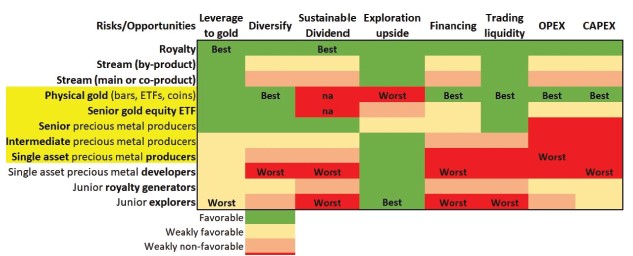
Gold’s strong performance has led Western investors to reassess their exposure to the metal considering various avenues, (Fig. 3). I have preferred royalty companies, which offer low risk but reduced leverage. Exploration-stage companies, with their value predominantly underpinned by drill results, also offer limited leverage.
Today, I will focus on another option: precious metal producers. The 21 primarily North American companies I included in my review have a cumulative market capitalization of ~US$220B but provided limited leverage to the gold price in 2023 due to shrinking operating margins.
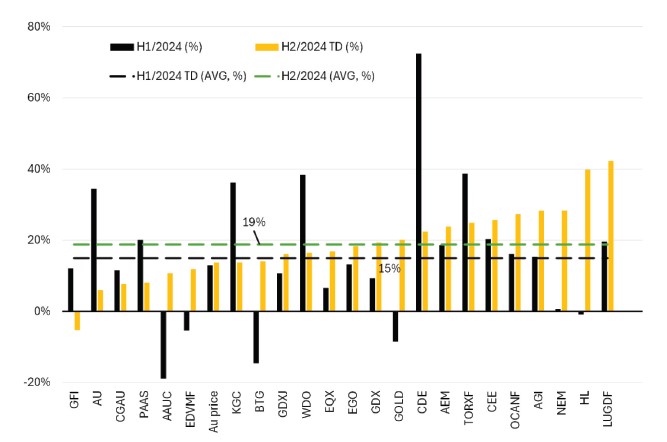
While the first half of 2024 (H1/2024) saw the two principal precious metal equity ETFs (GDX and GDXJ) trail the gold price (+13%), generating returns of +9 and +11%, respectively, (Fig. 4), the second half of the year (H2/2024) has shown a positive trend, with the indexes up 19% and 16%, respectively, compared to gold’s 13% increase. Though not spectacular, it represents the first point of a potential positive leverage trend for gold producers.
The companies varied widely in performance in H1/2024, from -19% (AAUC) to +72% (CDE), generating an average return of 15%. In H2/2024 so far, the average return is 19%, within a tighter range of -5% from GFI — due to a 20% drop year-on-year of its attributable production due to delays in the ramp-up of the Salares Norte mine in northern Chile, (Fig. 5), and backfill issues at the South Deep underground mine in South Africa — and +42% from LUGDF.
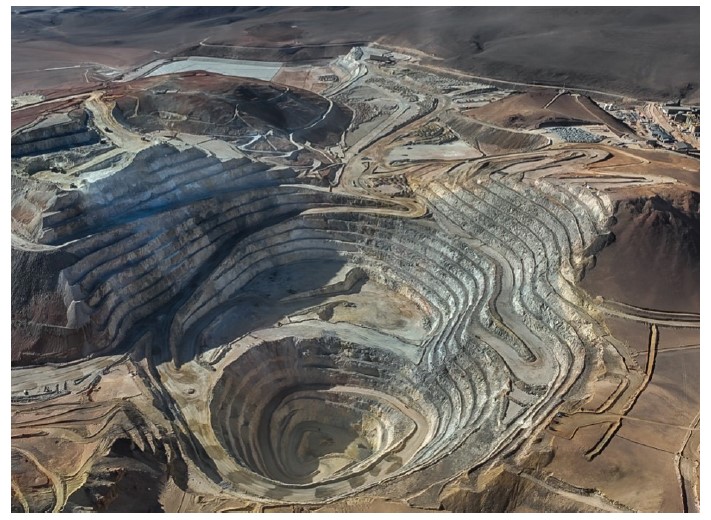
Western investors keen on gold again
This trend suggests that the gold price’s recent historic peak is driving broader investor interest beyond central banks seeking to diversify their holdings. Specifically, North America saw inflows two months in a row, adding US$1.4B in August, according to the World Gold Council, (Fig. 6). European funds attracted US$362M in August, the fourth consecutive monthly inflow, albeit at a slower pace than previous months. Asian funds extended their inflow trend to 18 consecutive months.
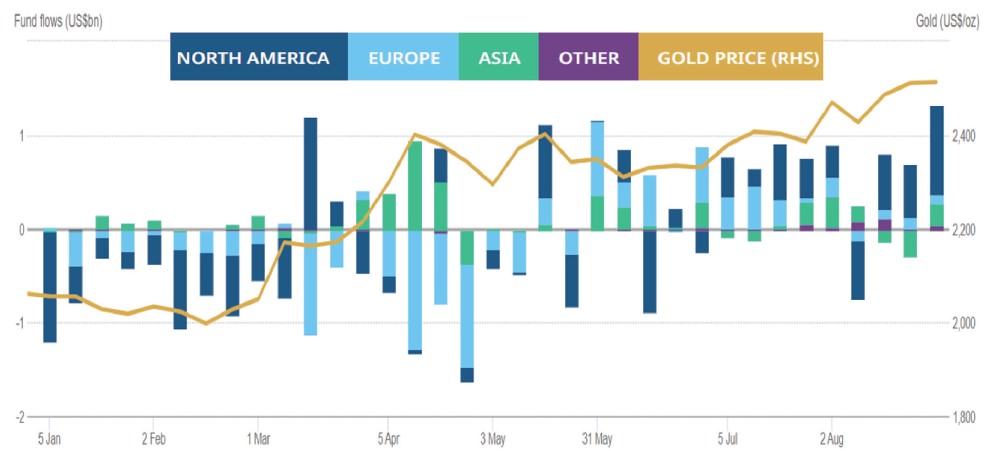
Gold price surge improves the operating margin
As higher production volume does not necessarily translate into better economic performance as the operating margin (revenue net of operating costs, not including corporate G&A, exploration, or financing costs) per every ounce produced is a critical metric to follow. Regardless, the gold price surge supported this metric.
The average operating margin for the 21 precious metal producers was 46% during the first half of 2024, while the all-in sustaining cost (AISC) margin was approximately 10% lower as it includes sustaining capital, (Fig. 7).
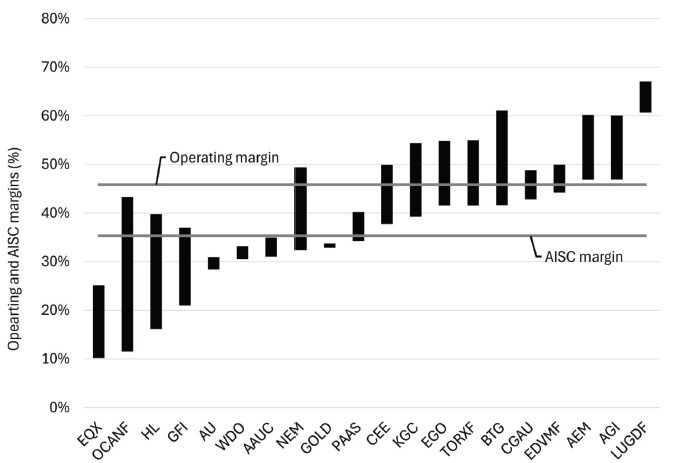
While only a few precious metal producers have managed to maintain or improve their operating costs, most have faced cost pressures for a variety of reasons:
- Treating lower-grade material
- Additional underground development
- Waste stripping before mining higher-grade
- Power issues in West Africa (Burkina Faso and Côte d’Ivoire)
- Gold price-related, e.g., higher royalties and payments to third parties (free carried interest)
- Weather-related (fires, rain)
On the positive side, single asset producer LUGDF — which I have previously highlighted to subscribers at the end of 2023 as a low-cost, high-margin gold production option offering downside protection with its high-grade Fruta del Norte underground mine in Ecuador. It reported record revenues in Q2/24, but its costs increased due in part to higher gold prices, which raised royalties and profit-sharing costs — a common theme among several producers. Nevertheless, LUGDF provided the best operating margin of the assembled peer group, (Fig. 8).
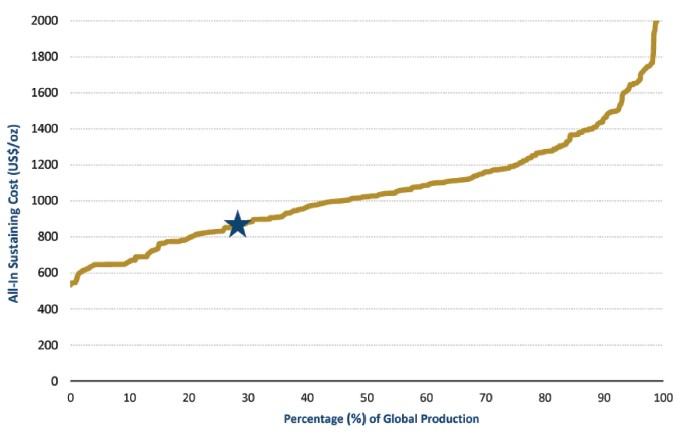
Another producer, AGI, achieved high margins in the first half of the year due to better grades from the Island Gold and Young-Davidson underground mines, combined with lower costs. AEM was the senior producer with the best margin, driven by solid production numbers from Canadian Malartic, La Ronde, and Fosterville.
On the opposite side of the spectrum is Americas-focused intermediate producer EQX, which I had singled out in the past for its high-cost (low-margin) profile. The company experienced a significant drop in production at the Aurizona mine in Brazil in H1/2024 due to heavy rains, which created geotechnical challenges, and the mine’s treatment plant had been idle for much of H1/2024. Additionally, the company decided to suspend mining operations at Castle Mountain in California until the Phase 2 expansion plan is completed.
But going forward, the company’s newest gold mine – Greenstone – is ramping up to commercial production and is set to become one of the largest in Canada, (Fig. 9).
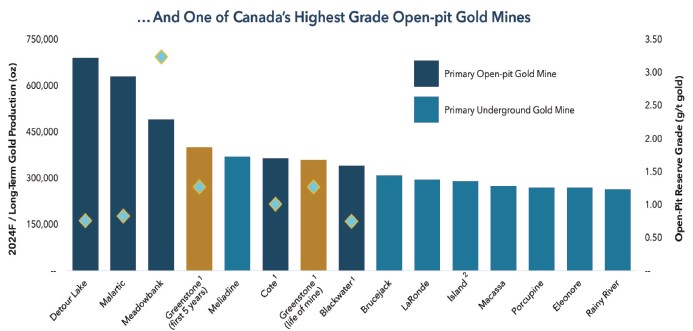
G&A, exploration, and financing costs a mixed bag
The gross margins only account for costs linked to operations but exclude corporate G&A, exploration, and financing expenditures. I examined how much companies spent on these cost centres, modeling them as a proportion of gross revenue during H1/2024, (Fig. 10). Silver companies (HL, CDE) and EQX spent the most on non-operating costs as a proportion of revenue (14-17%), while senior (GFI, 4%) and a few intermediate (AGI, BTG, TORXF) producers spent the least (5%).
Regarding G&A expenditures, senior producers (GOLD, AEM, NEM) spent the least as a proportion of revenue (1-2%) due in part to economies of scale, while the silver (HL, CDE) and junior (AAUC, OCANF) producers spent the most (6-8%).
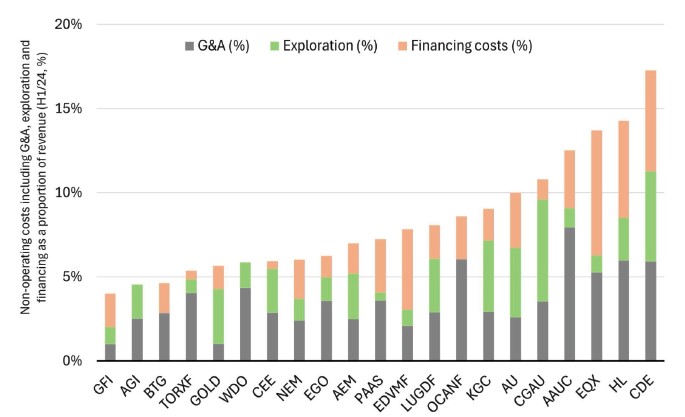
Companies spending the most on exploration include CDE and CGAU, followed by KGC and AU (4-6%). Among the senior producers, GOLD and AEM spent more on exploration than NEM, as the latter focused more on meeting its goal of divesting US$2B in assets, of which it has already received US$527M in proceeds this year.
The companies with the most significant financing burdens (EQX, HL, CDE, EDVMF) understandably have the highest financing costs as a portion of revenue (5-7%).
Some still generated negative free cash flow
The companies I reviewed generated US$2.7B in free cash flow (FCF) and an average of US$135M during the first half of 2024. Despite the positive move in the gold price during the first half of 2024, 30% of these companies reported negative free cash flow.
Note that FCF is not a Generally Accepted Accounting Principles (GAAP) measure; therefore, it can be subject to interpretation. I calculated it as operating cash flow net of investing cash flow from the cash flow statement.
I also looked at FCF yield (FCF/sh over share price) to gauge how much of the company’s valuation is explained by its FCF, (Fig. 11). The best performer was BTG, as its share price (denominator) has been hit by negative news out of Mali (Fekola excavator down, changes in Mali mining code) and escalating development costs in the Arctic. On the other side of the spectrum were EQX and AAUC.
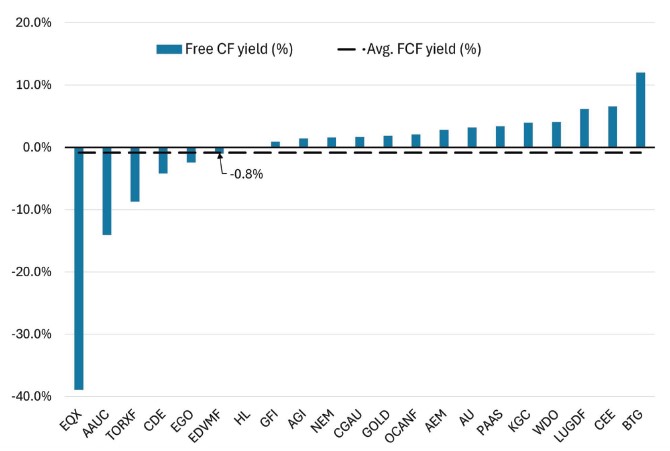
Returning cash to shareholders
FCF is cash that can be used to pay down debt, build new projects, buy back shares, or pay dividends. The peer group of 21 companies paid ~US$2.0B in dividends, with less than half not paying any dividends due to high debt positions and/or negative free cash flow. Senior producers NEM and AEM and intermediate producers PAAS and EDV were among those with highest dividend payouts, (Fig. 12).
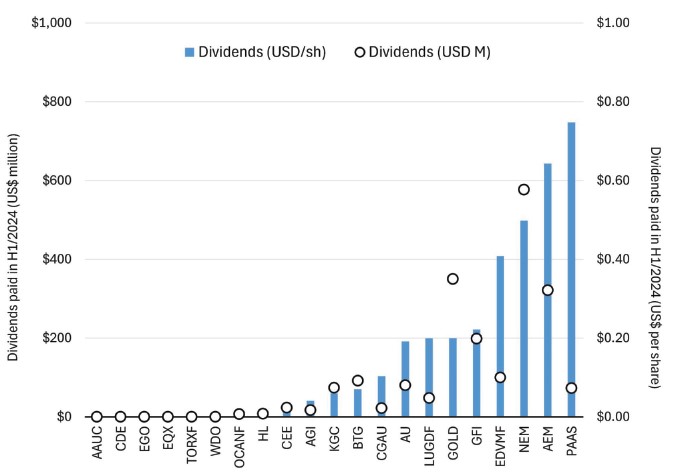
Balance sheets look healthier
A strong balance sheet is a good indicator of a company’s ability to fund its plans, and net debt (long-term debt net of working capital) is one of the preferred metrics to measure it. Among the sampled peer group, the average net debt at the end of June 2024 was US$290M, which is not egregious, (Fig. 13).
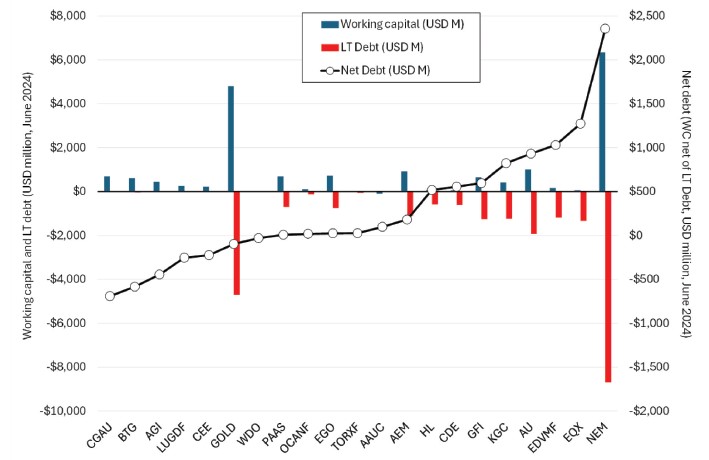
However, this average covers a wide range, from negative US$692M for CGAU to over US$2.3B for NEM post-merger with Newcrest Mining. About half of the peer group had negative or low-positive net debt positions of US$25 or less, which is healthy. CGAU currently holds the best net debt position.
A good example of a company eliminating its debt position is LUGDF, which generated enough FCF from its high-grade, low-cost operations in Ecuador to pay off its US$241M in long-term debt at the end of 2023, allowing it to increase its dividends.
However, some companies with significant negative net debt positions, like BTG, have raised funds through prepaid gold facilities with banks (US$517M) and a gold stream on the Back River project (US$158M). These appear on their balance sheets as long-term liabilities, highlighting that debt is not the only source of financing for gold projects, especially those in high geopolitical risk jurisdictions.
(Theoretical) 25% production growth potential
Mergers and acquisitions (M&A) are often driven by a company’s goal to expand its production profile, which is generally easier for companies with a smaller production base. I quantified the growth potential of the peer group of 21 precious metals companies by measuring the ounces outside their reserve pool, specifically in the inferred resource category.
The average growth potential was higher than expected at 25%, though it’s important to note that some resources in the inferred category may be problematic and never be upgraded, (Fig. 14).
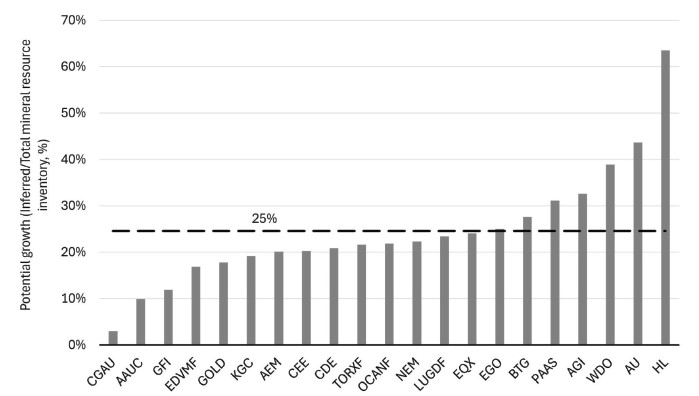
A broad spectrum of valuations
After evaluating a company’s ability to generate solid margins and positive free cash flow while controlling its corporate burn rate and maintaining a healthy balance sheet to fund growth opportunities, its current valuation is another crucial factor when deciding where to buy or sell your shares.
The enterprise value per ounce of reserves or resources (EV/oz) is a rudimentary but valuable metric that is not difficult to calculate. The peer group of precious metal producers averaged an EV/oz of US$196 for resources and US$469 for reserves, (Fig. 15). WDO is the most highly valued, followed by AEM, AGI, and LUGDF, with AAUC, PAAS, and EQX falling on the lower end of the spectrum.
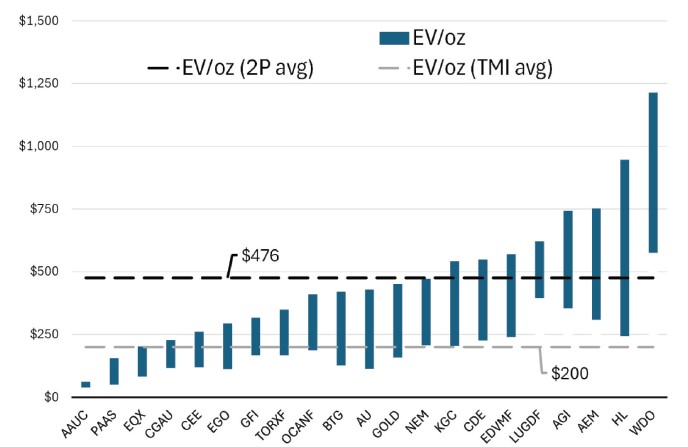
Summary and conclusions
The recent surge in the gold price, which hit a nominal high of well over US$2,600/oz, making it one of the best-performing assets in 2024, was driven by Central Banks’ buying and anticipation of US interest rate cuts, prompting investors, mainly European and American, to reconsider their exposure to ETFs and equities tied to the precious metal.
To gain leverage to the gold price in the current environment, I focused on a peer group of 21 precious metal producers listed in North America and compared their production, margin, non-operating costs, free cash flow, net debt, dividend payouts, and growth potential versus current valuation profiles.
Investors looking for opportunities offered by rising gold prices should consider well-positioned precious metal producers, which have shown strong performances across various metrics, including balance sheets, and are not overvalued compared to their peer group.












